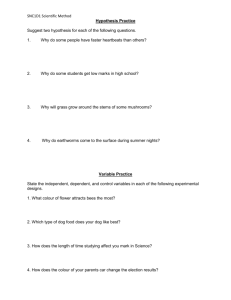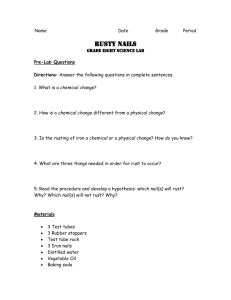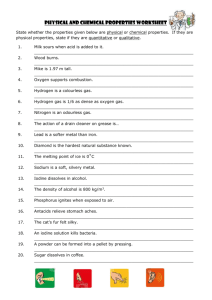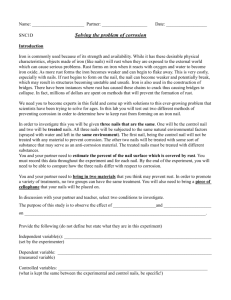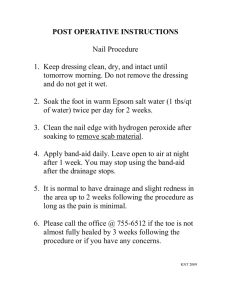Chemistry 12 IB Corrosion of Iron 1 Planning A
advertisement
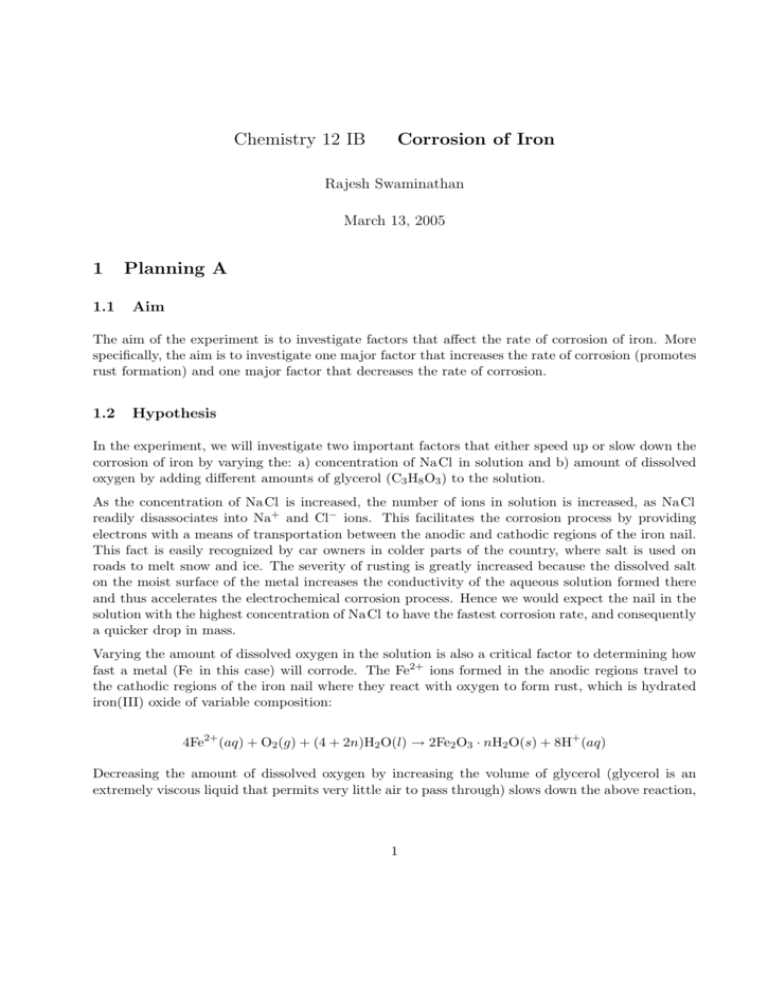
Chemistry 12 IB Corrosion of Iron Rajesh Swaminathan March 13, 2005 1 1.1 Planning A Aim The aim of the experiment is to investigate factors that affect the rate of corrosion of iron. More specifically, the aim is to investigate one major factor that increases the rate of corrosion (promotes rust formation) and one major factor that decreases the rate of corrosion. 1.2 Hypothesis In the experiment, we will investigate two important factors that either speed up or slow down the corrosion of iron by varying the: a) concentration of NaCl in solution and b) amount of dissolved oxygen by adding different amounts of glycerol (C3 H8 O3 ) to the solution. As the concentration of Na Cl is increased, the number of ions in solution is increased, as Na Cl readily disassociates into Na+ and Cl− ions. This facilitates the corrosion process by providing electrons with a means of transportation between the anodic and cathodic regions of the iron nail. This fact is easily recognized by car owners in colder parts of the country, where salt is used on roads to melt snow and ice. The severity of rusting is greatly increased because the dissolved salt on the moist surface of the metal increases the conductivity of the aqueous solution formed there and thus accelerates the electrochemical corrosion process. Hence we would expect the nail in the solution with the highest concentration of NaCl to have the fastest corrosion rate, and consequently a quicker drop in mass. Varying the amount of dissolved oxygen in the solution is also a critical factor to determining how fast a metal (Fe in this case) will corrode. The Fe2+ ions formed in the anodic regions travel to the cathodic regions of the iron nail where they react with oxygen to form rust, which is hydrated iron(III) oxide of variable composition: 4Fe2+ (aq) + O2 (g) + (4 + 2n)H2 O(l) → 2Fe2 O3 · nH2 O(s) + 8H+ (aq) Decreasing the amount of dissolved oxygen by increasing the volume of glycerol (glycerol is an extremely viscous liquid that permits very little air to pass through) slows down the above reaction, 1 and therefore slows down the rate of rust formation on the iron. We would thus expect the solution with the greatest volume of glycerol to show the smallest decrease in mass. 1.3 Variables Independent Dependent Controlled Uncontrolled 2 – – – – [Na Cl], Volume of glycerol added Amount of rust formed → mass of nail Amount of rust on nail (to prevent self-shielding) Temperature, Amount of oxygen entering the solution, Volume of solution (due to evaporation) Planning B 2.1 1. 2. 3. 4. Materials Required Iron nails (7) Sodium chloride powder Glycerol High-precision electronic balance 2.2 Procedure Part I 1. Scrape off any pre-existing rust on each nail to prevent self-shielding. 2. Weigh and record the initial mass of each nail with the aid of an electronic balance. Part II 1. Wash and prepare 4 identical beakers. 2. Measure out 3 different masses of NaCl (0.45g, 0.75g, 0.90g) and add them to the 3 beakers. Add no Na Cl to the fourth beaker. This will serve as a control. 3. Add enough water to each beaker so that the volume of each solution is 500 mL. 4. Place one nail in each solution in a slightly slanted position, and set aside the beakers in a cool, dry area. 5. Remove the nail from the solution every day (or every alternate day) and thoroughly scrape off any rust on the nail with the back edge of a spatula. Accurately record the mass of the nail using an electronic balance. 6. Put back the iron nails into their respective solutions, making sure to maintain the same orientation and height above water. Part III 1. Wash and prepare 3 identical test tubes and record their approximate radii. 2. Add different volumes of glycerol to each test tube and record its height in the test tube. 2 3. Add water to each test tube until the entire solution occupies about three-fourths the height of the test tube. Make sure that the volume of liquid (glycerol+water) in each test tube is the same. 4. Put one nail into each test tube and set aside the test tubes in a cool, dry place. 5. Remove the nail from the solution every day, scrape any rust off the nail, and record its mass. 6. Put back the iron nails into their respective solutions, making sure to maintain the same orientation and height above water. 3 Data Collection Attached 4 Data Analysis See attached graphs 5 Evaluation On scrutinizing the attached graphs, it is evident that the two factors a) concentration of Na Cl and b) amount of dissolved oxygen play critical roles in determining the rate of corrosion of iron. In the two graphs, we are more interested in the ∆mass of each nail, rather than the masses themselves. The curves which correspond to higher amounts of NaCl per liter show a sharper decrease in mass each day. Similarly, the nails in the test tubes with greater volumes of glycerol show a minimal change in their masses. These two observations are both in accordance with our hypothesis. Another noteworthy observation that can be made from the graphs is the way the nails first increase their masses and later come down. This may been because the nail wasn’t fully cleaned before its mass was measured, or could have been due to a zero-point error in the weighing balance. Although certain curves have radical extrema, we still look at only the change in mass between the first and fourth days. This unpredicted elongation is to be expected as even one miscalculated data point can considerably skew the graphs vertically. 5.1 Errors Since this investigation is not a quantitative analysis, any minute errors in either procedure or variable control will not show up significantly. We are only interested in observing the relative trends that result upon varying the factors that affect the rate of rust formation, and not a precise numerical value. Nevertheless, identification of sources of error is important in the event that a more refined investigation is conducted. 3 1. The solutions containing the iron nails were not maintained at a steady temperature. An increase in temperature accelerates the ions in solution and therefore increases the rate of the electrochemical reaction. On the contrary, as the temperature increases, the solubility of oxygen decreases, and thus the oxygen content of the solution constantly varies. 2. Allowance of uncontrolled amounts of oxygen into the solutions. Since it is unwise to assume that each solution gets exactly the same amount of oxygen each day, it is imperative that this variable be controlled more strictly. 3. Water (and the salt dissolved in it) was allowed to evaporate, which could changed the concentrations of Na Cl as the lab was being conducted. Furthermore, evaporation of water from the beaker reduces the amount of rust formation on the nail by decreasing the area that is exposed to moisture. 5.2 Procedural Improvements 1. Control temperature more tightly. This can be achieved by placing the apparatus in an oven equipped with thermostat control. 2. Disallow O2 entrance into the solution, by say, stoppering the beakers and test tubes. However, it is important to make sure that there is always at least some O2 for the electrochemical reaction to proceed. To overcome this problem, we could bubble a fixed amount of O2 into each solution every day. 3. Make sure that any evaporated water is returned back to the beaker by placing a lid of some sort over the beakers and test tubes. 4. Have more number of data points to spot trends more accurately. This has an added advantage because it could help us to answer quantitative questions such as: “What happens when the concentration of Na Cl is doubled? Tripled? Halved?” and so on. 6 Conclusion In this investigation, we have looked at two major factors that either speed up or slow down the amount of rust formation on an iron nail. We have seen that the more ions there are in a solution, the faster the nail corrodes. This might provoke car owners in regions where salt is used to melt ice to take additional steps to protect their vehicles. Similarly, storing a piece of iron in a vacuum could prevent it from corroding as oxygen and moisture is required for rusting. In addition to these two factors, there are many other factors that can inhibit corrosion such as painting, galvanizing or alloying. Since iron (or its alloy steel) is the main structural material for bridges, buildings and automobiles, controlling its corrosion is extremely important. Studying corrosion, and the factors that affect its rate is advantageous because corroded metals often lose their structural integrity and attractiveness, which could have great economic impact. Although corrosion is a spontaneous process, we can take advantage of the fact that it involves oxidation of the metal, and is therefore an electrochemical process. Thus any method that reduces the potential of the metal will hinder the corrosion process and protect the metal from further corrosion. 4 5


